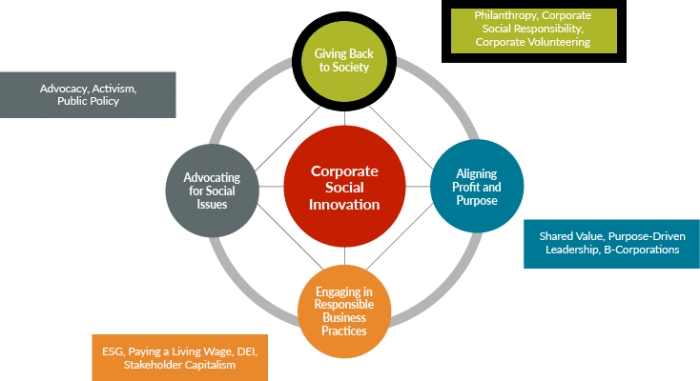
[This is the first of a four part series focused on the Rutgers Institute for Corporate Social Innovation’s “Four Pillars of Corporate Social Innovation.”]
You may have heard the adage “There is no business in a society that fails.” Over these four blogs, I explore the antithesis of this statement framed as a profoundly important question “What is the role of business in a society that SUCCEEDS?”
At RICSI, we believe that business in general, and business education in particular, can play a transformational role in addressing the greatest challenges of our time as defined by the UN Sustainable Development Goals (SDGs). We envision myriad possibilities opening up for humanity and business when we ground ourselves in a vision of a future where both society and businesses are flourishing; simultaneously taking care of people and the planet, all while prospering economically.
Here we frame our common journey for the success of both business and society in the context of a new, four pillar model of Corporate Social Innovation.
What is Corporate Social Innovation (CSI)?
Corporate Social Innovation is an evolving field, poised to make a transformative impact on the greatest challenges facing society. Fueled by radically changing perceptions around the role of business (e.g., Business Roundtable, Larry Fink/Blackrock’s letter to CEOs, Stakeholder Capitalism, etc.), CSI seizes on momentum for businesses to find innovative, sustainable paths forward to rebuild society.
At the Rutgers Institute for Corporate Social Innovation (RICSI), we engage purposefully with current and future business leaders to integrate societal needs into their business strategies and operations. As an outcome, we believe we can help build a stronger, healthier, and more sustainable world. RICSI’s four pillar model represents four paths forward, which can be used by companies as individual strategies or, optimally, in combination to build an integrated company-wide strategy.
Here we focus on innovative and practical examples of organizations stepping up to these challenges, while they address some of the most intractable economic, societal and environmental challenges facing our world today and tomorrow. Let’s start with the first pillar…
Giving Back to Society
One pillar in the RICSI Corporate Social Innovation framework is “Giving Back to Society,” and there are many compelling reasons why Companies give back to society. From an external perspective business benefits include positive branding and free publicity, differentiating your business, attracting new customers, and gaining customer loyalty and support. For example, research has shown that nearly 9/10 (88%) of consumers say they would buy a product from companies that focus their business on doing more than just making money.
From an internal perspective, giving back boosts your employees’ morale, and increases their engagement, commitment and loyalty to the company. A significant benefit for companies today is the extent to which it helps attract and retain top talent, especially Millennials and Gen Z. Over the long term, giving back to the communities where you live and work builds deep bonds and networks of relationships that ultimately translate into greater profitability. Last but not least, giving back makes people happier!
In our model of Giving Back to Society, we articulate three core streams of activity: Strategic Philanthropy, Corporate Social Responsibility, and Corporate Volunteering.
- Strategic Corporate Philanthropy
Strategic corporate philanthropy represents one approach to corporate or business giving, designed as an optimal way to align with the company’s overall mission, strategies, and values. Typically, it is not purely altruistic. Let’s explore three illustrative examples.
- Salesforce 1-1-1 Philanthropic Model.
Marc Benioff, CEO of Salesforce, is widely known for having promulgated his Foundation’s 1-1-1 Philanthropic Model. Since 1999, the company has been setting aside 1 percent of its equity, 1 percent of employee time, and 1 percent of its products to support its Foundation. The company aligns its philanthropic commitments with the core competencies and expertise of its talented employees. In turn, the Foundation supports programs dedicated to education, workforce development, and thriving Communities. Since its founding, Salesforce has given more than $240 million in grants, 3.5 million hours of community service, and provided product donations for more than 39,000 nonprofits and education institutions. Other companies such as Google, Zynga, Workday, Yelp and others have taken notice and implemented a similar model.
- BD Social Investment
As one of the largest global medical technology companies in the world, BD is committed to advancing the world of health by improving medical discovery, diagnostics, and delivery of care. Through its BD Foundation, the company targets the company’s strategic philanthropy initiatives to address unmet healthcare needs, improve healthcare access, and strengthen the capacity of health systems to provide preventive care to all patients, with particular emphasis on the most vulnerable populations. One of BD’s signature programs is “BD Helping Build Healthy Communities Innovations in Care Award” which funds community based health centers. Through this program, BD has enabled more than 29 million people in medically underserved areas to receive healthcare at community health center sites. To date $4.6 million has been awarded to 36 health centers in 19 states for these programs.
“We believe in a future where all people have the chance to thrive. That’s why we invest one third of our profits in grassroots efforts, like organizations creating change at the local level, and driving progress from the ground up.”
TOMS famously donated a pair of shoes for every pair they sold. This resulted in the donation of over 60 million pairs of shoes to children in need. They also used their profits to assist the visually-impaired by providing prescription glasses and medical treatments, provide safe drinking water and build businesses in developing countries to create jobs. More recently, after the company was beset by financial challenges in the highly competitive shoe business, TOMS continued its commitment to giving back to society, but evolved its one-for-one giving model to now donate one dollar for every three dollars it makes. According to the company this created a more sustainable and flexible model for giving.
- CSR and Corporate Volunteering
Corporate Social Responsibility (CSR) is a way for companies to be accountable to all their stakeholders for the impact they are having on society, including social, environmental, and economic. CSR comes in many forms. In Building a Culture for Sustainability, I shared nine “best practice” case studies of companies’ innovations in CSR (e.g., Alcoa, BASF, Church & Dwight, Pfizer, et al.). This inside-out, in-depth view demonstrated that there is no ‘one-size fits all’ approach to CSR. Rather, myriad industries and sectors are most successful when they customize their approaches to CSR in ways that uniquely suit their goals and culture.
Here we provide a few outstanding examples of innovative CSR programs that involve corporate volunteering to enhance the local community’s health and well-being. Millennials and Generation Z in particular, are keen to take part in CSR initiatives such as being able to participate in volunteer work in their local community, or making and having their donations matched towards a company’s charitable efforts.
Since 2010, Samsung has focused on enhancing STEM (science, technology, engineering and math) education across the U.S. by helping the next generation of students to develop their STEM skills while solving a problem in their community. The initiative addresses the sizable gap in education and career readiness in STEM skills in the U.S. vs. other countries through a nationwide classroom competition. In addition, Samsung has taken the “Day of Service” concept to a whole new level, as it transformed to a Month of Service in 2020, where employees perform acts of community service with non-profit organizations across the country.
Global pharmaceutical giant Johnson & Johnson, a 2021 Fortune World’s Most Admired Company, has been leading the way in meeting its CSR, corporate citizenship and sustainability goals. For more than three decades, the company has had a relentless focus on finding innovative ways to reduce waste and energy at its facilities worldwide. Its dedicated employees are so engaged in finding innovative ways to meet the company’s goals that they often exceed the ambitious targets, providing a multitude of examples of CSR in action. Johnson & Johnson’s initiatives range from leveraging the power of wind, to providing safe, clean water to communities around the world, to turning waste from sanitary pads into useable pads for women in Africa.
- WeSpire’s Novel Approaches
WeSpire makes extensive use of its innovative technology platform, based on behaviorally-based science and advanced data analytics, to create customized opportunities for companies and their employees to give back to society. For example, companies can place funds they are willing to donate into each employee’s account on WeSpire’s platform to make a donation. The program puts flexibility and control in the hands of the employees, as it enables them to choose where to direct the funds, how much to donate, lets them add to the donation, and allows the company to match if they choose. Using this novel model, 62% of the funds a corporation was willing to donate were used by their employees in just three months. More typically, research shows that the average employee participation rate in matching programs is only 10%.
Conclusion
As we look at the many challenges society faces, from poverty to food insecurity, to gender and racial inequality and inequity, to climate change and global warming, we see businesses in every sector and industry stepping up to meet the challenges of today and tomorrow through corporate social innovation. Here we have illuminated one of the pillars of CSI and shared multiple ways businesses are igniting these possibilities through strategic corporate philanthropy, CSR and Corporate Volunteering. We are inspired by the possibility of a new society emerging like a mighty oak from an acorn, as business and society work side-by-side towards a common vision of a society that succeeds, not just for some, but for everyone on the planet.
Be sure to check out our next blog #2 in the CSI series focused on “Aligning Profit and Purpose,” and featuring such best practice companies as Novo Nordisk, Unilever, Johnson & Johnson, Interface Carpet, Danone, et al.
References:
Benioff, M. (November, 2013). “Disrupting Corporate Philanthropy.” Stanford Social Innovation Review.
Farrington, J. & Rafferty, E. (Nov. 5, 2020). “BD Social Investing Overview.” Presentation to ‘Intro to Corporate Social Innovation.’ Rutgers Business School.
